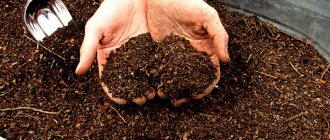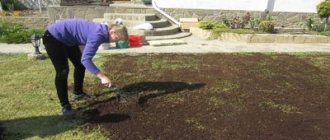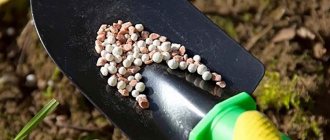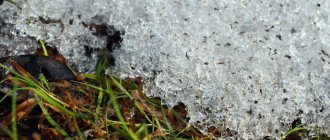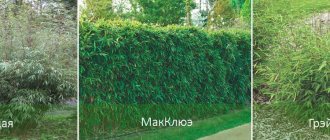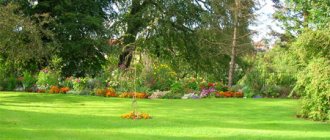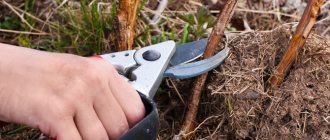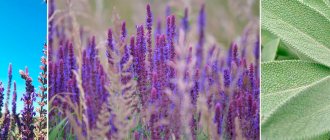The problem of the need for seasonal application of fertilizers in the spring is well known to every gardener or florist. In spring, one of the main tasks is to fertilize the soil. What fertilizers to choose for this and how to fertilize the soil in the spring at the dacha if there is no manure? This is what this article will talk about. At this time, plants especially need useful substances and elements, because the growing season begins.
Optimal timing of fertilization in spring
It is necessary to enrich the soil with mineral and organic substances in spring and autumn, as well as during the growing season. After the snow melts, it is recommended to add superphosphate and rotted manure, because in the initial stages of development, plants especially need nitrogen and phosphorus. If these fertilizers are not available, they can be replaced with others that have a similar composition.
We recommend reading these articles:
Sowing tomatoes for seedlings in 2022 according to the lunar calendar
Sowing peppers for seedlings in 2022 in Siberia according to the lunar calendar
Sowing pepper seedlings in 2022 in the Urals according to the lunar calendar
It is important that there is no snow or water left in the garden at the time of fertilizing. In the middle zone, the soil is ready for spring cultivation in the second half of April. If you use fertilizers too early, there is a chance that they will be washed away by water. More precise timing depends on what types of plants the substances are applied to. The soil under the trees is fertilized a little earlier, and the beds where vegetable seeds will be sown - later.
Release form
When choosing universal fertilizers for the garden in the spring, the form of release and the method of applying the complexes are also taken into account. Yes, for:
- For cereal crops, as well as for fertilizing lawns and flower beds, “Diammofoska” in granules has proven itself well.
- For decorative flowers, two-component (potassium-phosphorus) or three-component preparations containing nitrogen in liquid form are actively used.
- Annual crops (including garden crops) are fertilized with complex products in the form of solutions, and garden trees and shrubs can be fed with dry granules and powders during the process of loosening and mulching the root zone.
When it comes to choosing fertilizers for the garden in the spring, it’s difficult to say more about which ones are needed. Everything will depend on the type and structure of the soil, as well as on the variety of the plant itself. In order not to overload the soil with unnecessary minerals, it is important to focus on the appearance and condition of a particular plant, then the benefits of nutritional supplements will be maximum.
Benefits of spring feeding
In spring, it is advisable to apply a full range of fertilizers. Why?
It is possible to more accurately calculate the dose for each individual crop. In this case, predecessors are taken into account.
The amount of fertilizers is greatly reduced. The fact is that after autumn application, approximately 80% of the original amount of active substances remains in the soil by spring. This figure is not universal; some minerals (nitrogen) are very quickly washed out of the soil, while others tend to accumulate in it (potassium). If applied in the fall, the dose should be increased taking these factors into account.
An exception to this rule should be made for organic fertilizer (other than compost). Fresh organic matter introduced in the spring will not have time to rot and will not be fully absorbed by the plants. This, of course, does not matter, the organic matter will remain for next year, but labor costs increase.
Cons of organic fertilizers
Organics have many positive qualities - ease of preparation, environmental friendliness, and a wide range of applications. But there are also disadvantages and you need to be aware of them.
- An “overdose” of organic matter leads to the death of young, immature plants. In addition, an excess of such fertilizers negatively affects the taste of the fruit;
- the danger of infesting fields with weeds and plantings with fungi;
- unbalanced content of nutrients.
Organic fertilizers have an unpleasant, pungent odor. Delivery and distribution of them across the land requires large financial and power costs.
Signs of lack of fertilizers in the soil
The lack of one or another element in a plant can be determined by the following signs:
- Nitrogen: pale, sometimes yellowish, pinkish tops. The plant itself is developing slowly. The leaves are small, deformed, and may curl and fall off.
- Phosphorus: the tops acquire an unnatural purple, bluish tint, individual leaves curl upward.
- Potassium: burns appear along the edges of the leaf blades. The greenery itself becomes deformed and curls downwards. If the plant blooms, its buds dry out and fall off without producing a fruit.
- Magnesium: a deficiency of the element is indicated by yellowing of the leaves around the edges.
- Copper: the sheet plate unnaturally fades to almost white.
- Zinc: foliage becomes small, pointed, and covered with dark spots.
If it is difficult to determine the lack of a certain element, I advise you to carefully use a complex composition.
How to feed trees in spring?
Melting snow washes away the nutrients accumulated over the past season from the soil, and therefore the trees need to replenish their reserves. Nitrogen, which is so necessary for growing green mass, is the first to leave the soil. It is with the application of nitrogen to fruit trees that you should begin the gardening season.
Fertilizer is carried out 2-3 weeks before flowering. To do this, use one of the following solutions:
- 5% solution of urea, ammonium nitrate or bird droppings at the rate of half a bucket per 1 sq.m of tree trunk circle;
- 500 g of slurry diluted in 2 liters of water per 1 sq.m of tree trunk circle.
You can also quickly replenish nitrogen reserves by foliar feeding (spraying) with urea. A 0.3% solution is suitable for apple trees, 0.1-0.2% for pears, and 0.5-0.6% for stone fruits (cherries, plums, cherries, apricots).
Why can’t fresh mullein be introduced in the spring?
Fresh manure from farm animals (cow, horse, goat, rabbit, domestic, etc.) and fresh bird droppings (pigeon, chicken, duck, turkey, etc.) are not suitable for enriching the soil with organic matter in the spring, since non-composted feces contain a high concentration of urea , capable of burning the tender roots of seedlings and young seedlings.
In addition, fresh waste from birds and animals contains helminth eggs, weed seeds and other elements unfavorable for the chemical composition of the soil. And, if during 5-6 cold months of being in the soil, aggressive compounds evaporate, and organic matter partially decomposes and saturates the soil with humus and minerals, then in the 3-4 weeks allotted for pre-sowing tillage, this is impossible.
How to feed shrubs in spring?
Spring fertilization and feeding of berry bushes such as raspberries and gooseberries, currants and blackberries and, of course, various varieties of currants are not only an integral part of proper care for them, but also a guarantee that we will get a healthy plant that is more resistant to weather changes and diseases, which in turn will provide us with a good harvest.
We recommend reading these articles:
Sowing tomatoes before winter is a unique way of growing
Sowing tomatoes for seedlings in 2022 in Siberia according to the lunar calendar
Sowing tomatoes for seedlings in 2022 in the Urals according to the lunar calendar
There is a whole list of ready-made mixtures of mineral complex fertilizers that can be bought in specialized stores for gardeners, and recipes on how to make the desired “cocktail” yourself. Natural organic plant fertilizers do not lose popularity, but you should be careful with them. Experienced gardeners recommend root feeding of shrubs only in pre-watered soil, and foliar feeding in the evening, avoiding sunlight on the plants.
Types of fertilizers for the garden
The choice of specific compositions is entirely at the discretion of the owner of the site, depending on the possibilities for acquisition (self-preparation), the cost of the drugs in his region, and so on. You will have to buy complex and mineral fertilizers, but organic analogues are easy to either find in the area (in the same forest belt, at a poultry farm), or prepare in advance (accumulate a supply). Many gardeners are familiar with them, so just a reminder is enough.
- Humus.
- Compost.
- Wood ash.
- Peat.
- Bird droppings.
Many microelements useful for garden crops are contained in eggshells (for example, potassium), onion peels (you can collect them from stocks over the winter), and the peels of various vegetables and fruits. As a rule, such “fertilizers” can simply be scattered over the beds in the garden, and the precipitation will do its job.
I suggest watching the following video, where you will learn in detail how and in what proportions you should add horse and chicken manure, which will serve as an excellent fertilizer for a good harvest:
Complex fertilizers in spring
Complex fertilizers include the following products:
- Potassium nitrate. Contains 45% potassium and 13% nitrogen. It is a water-soluble substance and is considered a universal fertilizer for all crops growing on various types of soil. Fertilizing is used during the ripening period of root crops, when it is necessary to limit the nitrogen content and increase the level of potassium.
- Ammophos. The composition includes 50% phosphorus and 10% nitrogen. The mixture quickly dissolves in water and is well absorbed by plants. Can be used as a main fertilizer that increases the growth rate of garden crops and fruit ripening. During storage, the product does not absorb moisture and does not clump.
- Nitrophoska. The composition includes potassium, nitrogen and phosphorus, mixed in equal proportions. The product is used for root feeding when planting plants. This composition can be applied to any type of soil.
- Nitroammophoska. In addition to the 3 main inorganic substances, it contains sulfur. There are several types of product, differing in the percentage of beneficial compounds. The product dissolves in water; the composition can be used when growing any crops. The powder is applied to the soil in the autumn.
Proper nutrition for vegetables: creating a menu for the summer with diagrams and tables
How much fertilizer and fertilizing do plants need? How to find the optimal balance between mineral and organic nutrition, add useful elements for the benefit of vegetables and soil without harm to health? With a professionally developed nutrition system for each crop, this will not be difficult. You yourself will learn how to create a balanced menu for the entire season so as to provide the plants with a full range of nutrients. Our developments, nutrition plans and feeding tables will help you with this.
Plant nutrition system
Nowadays you can easily find special fertilizers created for specific crops: tomatoes, cabbage, cucumbers, potatoes, peppers, flowers, etc. They contain the necessary set of components and play an important role in plant growth. But are they sufficient for the entire period of growth and development, obtaining a high-quality harvest?
| Specially designed professional nutrition systems allow plants to be provided with a full range of balanced nutrients. |
Photo: Proper nutrition of garden and vegetable crops is a serious issue!
How did we develop plant nutrition systems?
Our fertilizers have been successfully used in agriculture for many years. This prompted us to adapt the developed nutrition systems from the professional sphere for amateur gardeners. Thanks to a competent nutrition system, the largest agricultural enterprises grow rich and guaranteed yields of vegetables and fruits.
For example, with a properly developed nutrition system, apple trees bear fruit every summer, cucumber harvesting begins earlier and lasts longer, and potatoes and other vegetables are perfectly stored in cellars all winter.
Photo: Now all the secrets of successful farms are available to every summer resident!
How does the plant nutrition system work?
A nutrition system is a set of special fertilizers (mineral, organomineral and microelement) for growing a specific crop and recommendations for their use on all types of soil.
- All fertilizers included in the Nutrition System are produced separately and are available for free sale.
- Using the instructions, you can independently create a nutrition system for any crop.
The nutrition system for each crop is based on 3 stages:
- Pre-sowing treatment of planting material (seeds, tubers, bulbs, etc.)
- The main application of organomineral fertilizers when planting in the ground
- Corrective feeding in summer during the growing season.
| Every element of the Nutrition System is important and contributes to the future harvest! |
Let's look at each stage of the power system in more detail.
Pre-sowing treatment of seeds, tubers, bulbs
At the initial stage of growth, first of all, you should “feed” the plants with a set of microelements - Fe (iron), Mn (manganese), Zn (zinc), Cu (copper), Ca (calcium), B (boron), Mo (molybdenum).
These elements have an amazing effect on plants:
- productivity increases,
- nutrients from the soil are completely absorbed,
- resistance to diseases, drought and cold increases,
- flowering improves,
- ovary growth accelerates,
- the level of nitrates in fruits decreases.
What fertilizers should be used to treat seeds when sowing?
It is very difficult to add the necessary microelements separately. It is good if they are included in a highly effective balanced complex of fertilizers in a form that is easily accessible to plants.
Therefore, we have developed the AQUAMIX microfertilizer, which contains all the necessary microelements in physiologically adjusted proportions:
- used for processing any planting material,
- eliminates chlorosis caused by micronutrient deficiency.
Using special fertilizer in liquid or solid form is much easier and there is no risk of over-application.
How to treat seeds with Aquamix?
1. Soak the planting material before planting in a 0.1% solution of Aquamix fertilizer:
- 1 g per 1 liter of water,
- 5 g packet per 5 liters of water
2. Leave for 8-12 hours. 3. The remaining solution can be used to treat seeds of other crops.
| If the seeds have already been prepared by the manufacturer, treated with plant protection products and/or growth stimulants, then soaking in Aquamix is not required! |
Photo: Aquamix microfertilizer for processing planting material
The main application of fertilizers to the soil during planting
As a rule, in the spring, basic fertilizers are used - for digging the soil, when planting:
- this base is the guarantee of the future harvest,
- under favorable conditions, plants are provided with food all summer.
| For basic fertilization, we consider organomineral complexes to be the best option. |
Organomineral fertilizer (OMF) is a complex granular fertilizer with prolonged action. It is used for the main application into the soil when digging or locally into the hole and planting hole.
- Produced from lowland peat.
- The composition includes humic compounds, macro- and microelements, as well as beneficial soil microflora.
- Does not contain chlorine!
| The unique properties of WMD make them an effective starting fertilizer for any crop! |
____________________________________
ORGANOMINERAL FERTILIZERS: TYPES AND APPLICATION ___________________________________
How does organomineral fertilizer work for the main application during planting?
Organomineral fertilizers have a powerful, prolonged effect. The roots of the plant receive nutrition from the granules.
Applied once at planting, they work effectively throughout the season:
- stimulate growth in early spring
- in summer - during the active growing season - they help development,
- in the fall, strengthen the plants for the winter.
Organomineral fertilizers can be used for growing seedlings and any field, garden, vegetable and ornamental crops.
Photo: Plant roots pierce an organomineral granule and do not get burned
Why is organomineral fertilizer better than others?
Compared to conventional organic and mineral fertilizers, organomineral complexes have a number of advantages:
- mobile elements, such as nitrogen and potassium, are not washed out of the granule by irrigation water,
- the percentage of nutrient absorption is 1.5 times higher compared to other fertilizers and amounts to 80-90%,
- no harmful insoluble compounds are formed in the soil, the humus content increases, the soil becomes loose and permeable,
- the harvest grows, the nutritional value of the fruit improves without a dangerous excess of nitrates,
- plants become frost-resistant and disease resistant.
| Organomineral granule is a microstorehouse for plants |
Photo: Complex granulated organomineral fertilizers for application during planting
Corrective fertilizing during the growing season of the plant
It may turn out that the fertilizers applied in the spring will not have the desired effect and will not provide the effectiveness that we expected from them.
| The fertilizer applied when planting in the spring is not always sufficient! |
From critical weather anomalies, from the chemical action of protective equipment:
- plants are stressed
- bioprocesses slow down,
- the root system does not take everything it needs from the soil
- the plant does not receive full development during growth, flowering, ripening, and fruiting.
| If the summer was rainy or cold, dry or too hot, short and late, the plants need additional feeding! |
Specially developed complex mineral water-soluble fertilizers and growth stimulants will come to the rescue. Experience and many years of practice show that it is best to apply such fertilizers in liquid form through watering and spraying on the leaves.
In agriculture, foliar feeding is used as a tool for relieving stress, adjusting nutrition and growth processes.
How do foliar amendments work?
All the main chemical reactions in a plant take place in the leaf blades, so adding nutrients through the leaf is reasonable and logical.
- With a depressed and poorly developed root and vascular system, the plant more easily absorbs nutrients through the leaves.
- The missing mineral components quickly enter the plant’s vital system, resuming chemical reactions.
- The roots are gradually connected to the process and begin to work in full force.
Foliar feeding helps the plant wake up faster and get out of stress.
| Interestingly, the benefits of foliar feeding were noticed even in favorable conditions. For example, spraying potatoes 2-3 weeks before harvesting with potassium fertilizers (monopotassium phosphate, Aquarin for fruiting or Fruit and Berry) showed an increase in yield, improved the quality and safety of tubers. |
Under ideal soil and weather conditions, foliar feeding may not be necessary.
What fertilizers are best to use for corrective fertilizing?
We have developed a modern, innovative remedy to help oppressed plants.
Aquarin is a water-soluble fertilizer with an optimal set of macro- and microelements for feeding plants through watering and foliar feeding.
- Microelements in its composition are contained in a form that is easily accessible to plants in the form of complex organic compounds - chelates.
- It is this form of microelements that is quickly absorbed by plants without being fixed in the soil.
- The technological composition allows you to reduce the dose of fertilizer and provides a quick visible effect.
How to use Aquarin fertilizer?
- Fertilizing is carried out with a fertilizer solution either early in the morning, or in the evening, or in cloudy weather.
- There should be no rain during and after treatment with Aquarin.
- Aquarin can be used independently and in combination with plant protection products.
| IMPORTANT The recommendations given have been tested and verified in science and practice on thousands of hectares of area. Our developments have received high international recognition and positive assessment from the most demanding specialists! |
Tomato nutrition system
The use of these fertilizers for tomatoes can be reduced if you use already treated seeds and “Magic Bed” seedling soil that is balanced in composition.
During the fertilizing period, we recommend carrying out 2-3 preventive treatments of tomato against fungal diseases (late blight, Alternaria blight, etc.) with an interval of 15-20 days.
The tomato nutrition system includes a set of complex fertilizers:
- microfertilizer Aquamix,
- WMD Growth,
- Aquarin for seedlings,
- OMU For tomatoes, peppers, eggplants,
- Aquarin Vegetable,
- Magnesium sulfate,
- Calcium nitrate.
Photo: Nutrition system for tomatoes - a set of complex fertilizers from the Buysky plant
Tomato fertilizing table
Photo: table of tomato fertilizing from sowing to harvesting
Cucumber nutrition system
The use of these fertilizers for cucumbers can be reduced if you use already treated seeds and “Magic Bed” seedling soil that is balanced in composition. In this case, the Aquamix microfertilizer for soaking seeds and the organomineral fertilizer Rost are not used.
The cucumber nutrition system includes a set of complex fertilizers:
- microfertilizer Aquamix,
- WMD Growth,
- Aquarin for seedlings,
- OMU For cucumbers, pumpkins, squash,
- Aquarin Universal,
- Calcium nitrate.
Photo: Nutrition system for cucumber - a set of complex fertilizers from the Buysky plant
Cucumber feeding table
Photo: table of cucumber feeding from sowing to fruiting
Cabbage nutrition system
The use of these fertilizers for cabbage can be reduced if you use already treated seeds and “Magic Bed” seedling soil that is balanced in composition.
The nutrition system for cabbage includes a set of complex fertilizers:
- microfertilizer Aquamix,
- WMD Growth,
- Aquarin For Seedlings,
- OMU For Cabbage,
- Aquarin Vegetable,
- Magnesium sulfate,
- Calcium Nitrate,
- Potassium Nitrate.
Photo: Nutrition system for cabbage - a set of complex fertilizers from the Buysky plant
Cabbage feeding table
Photo: cabbage feeding table from sowing to fruiting
Potato nutrition system
During the period of fertilizing potatoes, we recommend carrying out 2-3 preventive treatments of potatoes against late blight, Alternaria and Colorado potato beetles with an interval of 15-20 days.
The nutrition system for potatoes includes a set of complex fertilizers:
- microfertilizer Aquamix,
- OMU Potato,
- Calimagnesia,
- Calcium Nitrate,
- Aquarin Universal,
- Aquarin Potato.
Photo: Nutrition system for potatoes - a set of complex fertilizers from the Buysky plant
Potato feeding table
Photo: table of potato fertilizing from tuber processing to fruiting
Root crop nutrition system
Suitable for feeding carrots, beets, radishes, turnips, radishes, celery, turnips, rutabaga. Seeds treated by the manufacturer with protective agents and growth stimulants are not soaked in the Aquamix solution. Microfertilizer Aquamix can be used for spraying and watering: 5 g per 10 liters of water. Measuring spoon (10 g) included.
The nutrition system for root crops includes a set of complex fertilizers:
- microfertilizer Aquamix,
- OMU For carrots, beets and other root vegetables,
- Aquarin For Seedlings,
- Aquarin For Fruiting.
Photo: Nutrition system for carrots, beets and other root crops - a set of complex fertilizers from the Buysky plant
Root vegetable feeding table
Photo: table of feeding root crops from sowing to harvesting
Strawberry (strawberry) nutrition system
Foliar feeding of strawberries with the Aquarin fertilizer can be carried out in conjunction with means of protection against strawberry diseases and pests. Measuring spoon (10 g) included.
The nutrition system for strawberries (strawberries) includes a set of complex fertilizers:
- OMU For strawberries (strawberries),
- Aquarin Strawberry,
- Aquarin universal,
- Aquarin for Fruiting,
- Monopotassium phosphate.
Photo: Nutrition system for strawberries (strawberries) - a set of complex fertilizers from the Buysky plant
Strawberry fertilizing table
Photo: table of fertilizing strawberries from planting to harvesting
Lawn nutrition system
Lawn grass seeds treated by the manufacturer with protective agents and growth stimulants are not soaked in the Aquamix solution. Microfertilizer "Aquamix" can be used for spraying and watering the lawn: 5 g per 10 liters of water. Measuring spoon (10 g) included.
The lawn nutrition system includes a set of complex fertilizers:
- microfertilizer Aquamix,
- OMU Lawn,
- Aquarin Lawn,
- Monopotassium phosphate.
Photo: Lawn nutrition system - a set of complex fertilizers from the Buysky plant
Lawn feeding table
Photo: table of lawn fertilizing in the 1st and subsequent years
We wish you large, tasty and healthy harvests!
_______________________________________________
As an advertisement
Fertilizing the soil with manure in spring
In spring, fresh manure is not applied to the soil, because it can burn the root system of planted vegetable plants. Therefore, rotted horse manure or mullein is usually used as soil fertilizing in the spring. Typically, manure is collected during the summer and autumn, and applied to the ground only in early spring. This organic fertilizer saturates the soil with nitrogen, which is extremely necessary for cultivated plants during the growth period - this microelement accelerates the growth of shoots and vegetative mass. In addition to nitrogen, manure also contains other macro and microelements necessary for the full development of cultivated plants in the garden plot.
Typically, manure should be applied to the soil immediately after the snow melts. Typically, this organic fertilizer is sprinkled over the area immediately before digging the soil, after the soil has warmed up sufficiently after winter. However, when applying organic fertilizers, you should remember that an excess of them is just as harmful to plants as a lack. 10 kg of manure is applied per 1 m2 of soil - this amount of this organic fertilizer is quite enough to saturate the soil with useful substances.
If there is not too much manure to fertilize the entire garden, then this rotted organic fertilizer is applied directly to the planting holes.
Slurry can also be used as a top dressing in the spring. It is prepared as follows: rotted manure is diluted with liquid (5 liters of water are taken per 1 kilogram of manure). This liquid fertilizer is used to fertilize fruit trees and planted vegetable plants in the spring. Berry bushes, strawberries, apple trees, pears, and stone fruit trees are especially responsive to such feeding.
The application of rotted manure improves the composition of the soil, so it is also used as mulch. The application of this organic fertilizer helps plants absorb the applied mineral fertilizers faster and better. Therefore, experienced gardeners apply manure to the soil during the spring.
Important tips for spring fertilizing plants
We have figured out WHAT to fertilize the land, but this is clearly not enough to achieve a positive result. It is important to know HOW to supplement correctly.
For spring feeding, choose complex mineral fertilizers with a high nitrogen content. Look carefully at the packaging. In the abbreviation NPK, opposite the first letter N, corresponding to nitrogen, should be the largest numerical value.
Do not fertilize too early; wait until the snow cover melts. Some gardeners break this rule and make a mistake - useful substances “leak away” along with the snow. Fertilizers in granules are applied in March - they take a long time to dissolve, liquid fertilizers - in April-May. If the soil is too dry, water it before planting.
You need to fertilize where there are a lot of roots. That is, not under the very trunk of the tree, but around it. After adding granular nutrient mixtures, the soil must be loosened.
When applying fertilizers, it is important to consider the type of soil. You can determine what kind of soil you have in certain areas (acidic, alkaline or neutral) in the laboratory. This is the most reliable option, however, if there is no opportunity to give soil samples for research, you should not despair. Folk signs will come to the rescue. It has long been noted that moss, plantain and horsetail prefer acidic soils, quinoa and mustard - alkaline, clover and nettle - neutral.
Each type of soil has its own fertilizer.
Compost and grass mulch can be applied every year, and manure and litter can be applied every two years. Sawdust, which is added to organic matter, improves the flow of moisture into the deeper layers of the soil, which means it accelerates the absorption of nutrients. The depth of the bookmark is of great importance. You will achieve the greatest efficiency if you place fertilizers at the depth of the shovel blade.
Organomineral granular fertilizers are recognized as the best. They are able to dose the release of useful components to the roots - the plant receives first of all those that it urgently needs. Single-component mineral supplements require careful attention, because affect the composition of the soil (degree of salinity, acidity, etc.).
How to fertilize the soil in the spring if there is no manure?
If organic fertilizers are not available, use mineral fertilizers. Don't be afraid that your vegetables will have elevated nitrate levels. If you do not abuse it, but use the recommendations printed on the packaging, then nothing bad will happen. An increase in nitrates can also be obtained by using too much organic matter. If you are an ardent opponent of mineral fertilizers, then you can use turf soil during planting.
But this work is very labor-intensive. The essence of this method is that you need to dig out a layer of turf as deep as the bayonet of a shovel and beat the soil directly onto the garden bed (or into a prepared container) on the handle of the shovel, and then dig shallowly. Of course, you can’t plant a large area this way, but it’s quite possible to prepare a couple of beds. In the spring, you can bury last year’s grass and leaves directly into the garden bed (just not from city streets) - gradually rotting in the ground, they will provide the plants with some kind of nutrition, albeit incomplete. Ash should also be added there. The best substitute for manure will be compost, but the process of preparing full-fledged compost is very long - two or three seasons, and therefore, if you have problems with manure in the future, then take care of preparing it now.
Spring fertilizing of the soil using green manure
Often, green manure is increasingly used as fertilizer in garden plots. Green manures are plants that are sown and then plowed into the ground, thereby improving its composition. The following grain crops are used as green manure:
- buckwheat;
- wheat;
- oats;
- lupine;
- mustard and some other plants.
When sowing plants for fertilizer, those with well-developed roots and a large amount of vegetative mass are selected. Such plants must have a short growth period, which is why they are planted as green manure. What plants to plant to improve the soil depends on its condition. Cereals planted as fertilizer are equivalent in productivity to horse or cow manure.
Rules for feeding in a polycarbonate greenhouse
In order for greenhouse plants to grow well and enjoy growth until the flowering period, they are fed with nitrogen-containing preparations.
The soil needs to be warmed, and to do this, straw or tops are buried in the ground. You also need to add manure to the soil, which will help create a thermal effect. On top of the layer of manure, lay a layer of earth enriched with mineral preparations and ash. This is followed by a hot “shower”. And then the beds are covered with polyethylene. Thanks to the greenhouse effect, the earth will warm up and be ready for planting seedlings.
Black leg on seedlings: how to fight
Soil disinfection in the spring before sowing
Improving and cleaning the soil from pathogenic bacteria and pests is one of the most important stages of preparation for sowing. The destruction of microorganisms that pose a danger to cultivated plants is carried out using chemical, biological and thermal methods.
The first involves treating the soil with chemicals: sulfur, copper sulfate, chlorine, etc. The methods are effective, but it must be taken into account that toxic substances can also get into the fruits, which are then eaten.
Disinfection with biological products is safer than chemicals. Such products contain special fungi and antibiotics that can destroy only harmful microflora and fauna.
Thermal methods involve treating open ground with low or high temperatures.

